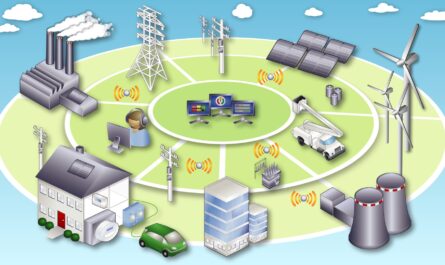As renewable energy sources like solar and wind continue to grow globally, the need for affordable and efficient energy storage solutions is more important than ever. Lithium-ion batteries have been the dominant solution for small-scale energy storage applications, but they face challenges scaling up for utility-scale storage needs. This is where flow batteries could provide an alternative with their potential for cheaper, longer-lasting and larger-scale storage capacities. Let’s take a deeper look at flow batteries and how they might play a role in transforming the energy landscape.
What are Flow Batteries?
Flow batteries store energy in chemical solutions held in external tanks instead of within the battery unit itself. When the battery is “charged”, the solutions containing the electroactive materials are pumped from one electrochemical cell through a membrane where a redox reaction occurs to store energy chemically in the solutions. During discharge, the reaction runs in reverse to release the stored energy as electricity.
The key attribute that distinguishes Flow Batteries from conventional solid-state batteries is that the energy capacity of flow batteries scales independently from power capacity by simply increasing the size and volume of the electrolyte tanks. This allows flow batteries to economically provide multi-megawatt hour storage solutions needed by utilities. Another advantage is that the electrolyte liquids in flow batteries can undergo tens of thousands of charge-discharge cycles over their 20+ year lifetimes, far surpassing the lifespan of lithium-ion batteries.
Current Flow Battery Chemistries
Vanadium Redox Flow Batteries
One of the leading and most commercialized flow battery technologies is the vanadium redox flow battery (VRFB). VRFBs use vanadium ions that can exist in four different oxidation states – V2+, V3+, V4+ and V5+ – dissolved in an electrolyte solution. During charging, the V2+ ions in the negative electrode tank are oxidized into V3+ ions while the V5+ ions in the positive electrode tank are reduced into V4+. Discharging simply reverses the redox reactions.
VRFBs can be scaled up incrementally and hold their charge almost indefinitely when fully charged, though self-discharge does occur slowly over time. They have demonstrated thousands of cycles with 85-95% efficiency and multi-decade lifetimes. However, VRFBs also have relatively high capital costs today of $250-450 per kWh, limiting their widespread adoption for utility-scale storage. Researchers are working on improving the technology and lowering costs through materials optimization and innovations. Pilot VRFB projects have already shown promising results, paving the way for broader commercial use cases.
Zinc-Bromine Flow Batteries
Another contender is the zinc-bromine (Zn-Br) flow battery, which works by plating and stripping zinc between a zinc negative electrode and a bromine positive electrode. During charging, zinc ions in the electrolyte are deposited on the negative electrode while bromine is oxidized to form bromide ions. The process is reversed during discharge.
Zn-Br flow batteries have the advantages of utilizing low-cost and earth-abundant materials like zinc and bromine. They have generally higher energy densities than VRFBs. Early versions also demonstrated multi-decade lifespans and round-trip efficiency in the 70-80% range. However, dendrite formation and self-discharge issues had limited the technology. Recent battery designs are trying to address these challenges through membrane and electrolyte modifications to enable wider commercial adoption of this chemistry.
Potential Flow Battery Applications
Flow batteries are well-suited for utility-scale energy storage applications because of their ability to economically provide multi-megawatt hour capacities needed by the power grid. Some key areas where flow batteries could play a transformative role include:
Renewable Energy Integration
As the penetration of solar and wind power increases on the grid, storage plays a crucial role in absorbing their intermittent output and discharging it when renewable production drops off. Flow batteries are an optimal solution here given their ability to store tens of MWh of energy comparable to the output of large wind or solar farms. This allows integrating high shares of renewables onto the grid reliably.
Transmission and Distribution Upgrade Deferral
Flow batteries offer utility operators a flexible alternative to costly transmission and distribution infrastructure upgrades. By deploying storage at spots prone to congestion or load fluctuations, flow batteries can alleviate stress on the network during peak demand periods in a more cost-effective manner than laying new wires. This helps postpone or avoid unnecessary capital expenditures.
Microgrid and Islanding Applications
Because of their long lifespan and flexible scalability, flow batteries are also being tested for off-grid microgrid energy storage applications. By powering critical infrastructure like remote telecom towers, airports or island communities, flow batteries provide backup power resilience and allow higher incorporation of renewables into isolated grids not connected to the main power lines. This brings electricity access to under-served regions.
Ancillary Grid Services
Flow batteries could also participate directly in electricity markets by providing important ancillary services to maintain grid stability like frequency regulation, voltage support and backup reserves. These services have become increasingly valuable revenue streams for storage as more intermittent resources come online. The ability of flow batteries to shave peaks and shift loads make them suitable assets for these grid balancing roles.
Market Outlook and Barriers to Adoption
While still in the early commercial stages compared to lithium-ion, the global flow battery market is growing substantially each year. According to some estimates, the market could be worth up to $3.6 billion by 2030 as costs decrease and more large-scale projects come online. Pilot deployments have already been demonstrated around the world in Asia, Europe, Australia and the Americas totaling over 60 MW/200 MWh of flow battery capacity installed to date.
However, for flow batteries to achieve widespread adoption, several barriers still need to be overcome. Chief among these are further reductions in capital costs per kWh, which are still higher than other storage technologies today except for specialized applications. Reliability standards also need enhancing, along with streamlined project development processes. Expanding manufacturing scale and supply chains will be essential to drive down costs. With continued private sector investment and innovation, flow batteries appear poised to unlock new opportunities for large-scale renewable integration and grid services worldwide.
As the energy industry evolves rapidly, flow batteries present a compelling alternative for meeting future requirements



